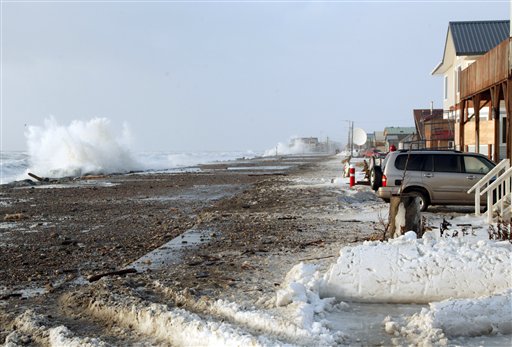
So far, 37 communities have reported some form of damage, said Jeremy Zidek, spokesman for the state's emergency management agency.
The strongest storm to hit the state in four decades also left behind tales of human endurance.
In one remote village that lost heat and power early Wednesday, about 20 vehicles lined up along an air strip and used their headlights to guide in a plane carrying repair workers.
Other residents came together and did traditional Eskimo dances used during whaling season to seek good weather.
On Thursday, rescuers searched for a 26-year-old man who authorities said may have been washed into the Bering Sea during the storm.
Kyle Komok of Teller was last seen at 4 p.m. Wednesday as he headed toward a jetty where waves were cresting as high as 10 feet, Alaska State Troopers said.
Emergency responders called the storm an epic event that displaced residents, flooded the shoreline, ripped up roofs and knocked out power in scores of villages.
Officials said Thursday the process of gauging the full extent of the damage will begin soon. They noted some of the hardest-hit communities are in areas where winter daylight comes late in the day and mornings are in pitch darkness.
Forecasters said another storm is stepping in to replace the tempest, but the new storm is much weaker. It is expected to bring winds ranging from 20 to 40 mph, said National Weather Service meteorologist Don Moore. In comparison, the storm that pounded the Bering Sea coast this week carried gusts of nearly 90 mph and created tides as high as 10 feet above normal.
Though far less powerful, the new storm will keep water levels from receding as quickly, Moore said.
Communities hard hit include the northwest Alaska villages of Point Hope, built on a large gravel spit, and Kivalina, one of the most eroded communities in the state.
Point Hope Mayor Steve Oomittuk said homes in the Inupiat Eskimo community have been without electricity and heat since early Wednesday, after winds gusting at 80 mph slammed an old wooden shack into a power pole with five main lines, cutting it in half. The building then broke apart, sending wood flying.
"There's a lot of debris in that area," Oomittuk said Thursday morning, soon after repair workers landed at the air strip.
With the lights out, vehicles lined up along the runway to guide the plane with headlights.
Oomittuk said the winds were too strong during the storm to get a full picture of the damage around the community.
More than 500 of Point Hope's nearly 700 residents have been staying at the village school, which has its own generator. Among them was Nellie Sears, the school librarian. She said every classroom was full of residents seeking shelter.
For a while there was a warning Wednesday that the barreling storm could get worse. So villagers started performing the traditional Eskimo dances they do during whaling season, when they are seeking good weather. Just before 10 p.m., they got word that the warning had been cancelled, Sears said.
"We dance to get help," she said.
Kivalina, 75 miles down the coast, got a "good surge from the ocean," said village spokeswoman Colleen Swan. But mornings are very dark and the extent of flooding was not immediately known beyond water washing over the village dump site and onto the beach, she said.
Most of the community's 460 residents, including those nearest the ocean and lagoon, were evacuated to the school, so it was unknown if the water reached any homes.
Swan said the door of a community building was ripped off during the storm's fury. When she awoke Thursday morning, there was a quiet stillness.
"The moon is out. It's very beautiful," she said. "It is very calm, as if nothing ever happened."
The storm battered the ocean-front homes in the tiny village of Shaktoolik, but structures appeared to have been spared, said Michael Sookiayak, a planner for the Shaktoolik tribal council.
"There has been no preliminary reports of major damage here in Shaktoolik," he said Thursday morning. "Of course, that might change over the course of a day."
Sookiayak is among those who live on the ocean front.
"I think the worst part for me and my family ... was watching the waves come up closer and closer to the houses on the ocean side of the community," he said.
The waves crested over the 2009 storm line, which is just a few feet from the homes, Sookiayak said.
A few families evacuated to the school, including Sookiayak's children, but he rode out the storm Wednesday at home.
"I think this storm tested the will of the people in Shaktoolik," he said. "There was a lot of anxiety in the community."
Still of concern is a little spit of land about 3 miles from the community surrounded by a river on one side and the ocean on the other, separated by just a few feet.
Sookiayak said officials haven't yet had a chance to survey the area.
"And if that ocean erodes into the river, then we basically become an island," he said.
Amateur footage taken during the storm. Original video and rights belong to Carol Seppilu via Facebook.
She writes: "8pm on 11/8/11. This isn't too bad, we've seen worse on St. Lawrence Island. But this is pretty bad for Nome and it's gonna get worse later on tonight."



Reader Comments
to our Newsletter